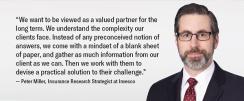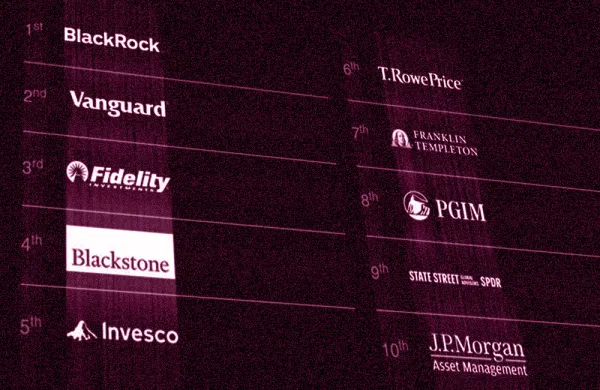Fixed income still commands the lion’s share of asset allocation for insurance companies, but after a decade of historically low interest rates and rich valuations, insurers are searching for incremental returns. That task may lead them afield into new territories, especially on the private and alternatives side. “Everyone’s thinking, if there’s no clear opportunity, what is my best relative option? Where am I best served to put money to work as I seek to find that return without disproportionately increasing risk?” asks Peter Miller, Insurance Research Strategist at Invesco.
Aside from economic considerations, insurance companies must contend with the regulatory and accounting considerations that continue to steer them toward a fixed income focus. Moreover, firms face additional challenges, such as a competitive underwriting environment and evolving liability risks such as cyber and climate-related risks. These factors lead to increased pressure on the asset side to deliver returns.

Moving farther out the risk spectrum
One approach to adding yield is common – for example, shifting from investment grade to high yield credit – but it may also lead to a clear increase in risk. For many insurers, the answer has not been to simply add credit risk. Instead they might be contemplating “off-the-run” assets with an embedded complexity premium, emerging markets exposures, or less liquid parts of the market. Private credit, which may feel like less of a leap and more of an incremental step since credit is already the mainstay of insurance asset allocation, has also been attracting significant attention.
Certainly, any insurance company needs to consider the liability side of the balance sheet and its interaction with the asset side when making changes to investment strategy. This is most often associated with life insurers, who devote significant resources to asset-liability management (ALM). However, health and property & casualty (P&C) companies also spend considerable time thinking about their liability duration profile relative to assets. “Interestingly, we’ve spoken to a number of insurers across life, health, and P&C who feel they have more liquidity than they realistically need. To many of them, less-liquid assets may be a relatively safe way to add return to their investment portfolios,” says Miller.
New opportunities
Some insurers are also turning more to equities and alternatives to fill their riskier, non-core buckets, albeit still with relatively modest allocations. These often reside in surplus portfolios which are not directly backing any particular set of liabilities. “Though some companies don’t explicitly segment investment portfolios that way, they often do some mental accounting,” says Miller.
Sometimes the change in strategy is nuanced; for example, rather than looking for higher-alpha equity strategies, they may pivot to passive, traditional cap-weighted funds and ETFs, as a route to more cost-effective equity exposure. Or they may begin looking at factor-based strategies as another way to obtain cost-effective equity exposure. These approaches may result in better after-fee returns in situations where insurers aren’t getting the alpha they are paying for in traditional active strategies. “Even if it’s a small proportion of their overall total assets, there are still big dollars at stake,” Miller notes. Other asset classes increasingly in focus for insurers may include private equity, infrastructure and real estate. Again here, even a small percentage allocation tends to be a high dollar one.

Asset managers’ value proposition
Core fixed income portfolios are generally managed internally by the large insurance companies. Mid-level and smaller firms lean toward more investment outsourcing. For non-core strategies like alternatives, it can be more efficient to use external managers, who can bring expertise and specialized resources. “Even some large insurers may have a very specific, niche problem,” Miller says. “They might oversee 95% of their assets internally but would like assistance or a second opinion on a unique situation. We strive to adapt our approach to the unique situation of each client we work with. Our goal as an Insurance Solutions team is for each client to feel like we are an extension of their team.”
Invesco has individuals on its team with experience directly in, or supporting, the insurance industry, and that’s a key ingredient to success. Whether through hands-on experience as an employee or many years of covering insurance companies as clients, or both – this experience is critically important in fostering relationships with insurers and understanding their technical challenges.
“Our clients expect a lot of detail and transparency from us,” says Miller. “We want to be viewed as a valued partner for the long term. We understand the complexity our clients face. Instead of any preconceived notion of answers, we come with a mindset of a blank sheet of paper, and gather as much information from our client as we can. Then we work with them to devise a practical solution to their challenge.”
Start the conversation to better outcomes. Learn more.
Disclosures:
All content provided by Invesco is for informational purposes only and is not an offer to buy or sell any financial instruments.
The opinions expressed are those of the authors, are based on current market conditions and are subject to change without notice. These opinions may differ from those of other Invesco investment professionals.
Invesco Advisers Inc. is an investment adviser; it provides investment advisory services to individual and institutional clients and does not sell securities.
Asset allocation, diversification and low or negative correlation do not guarantee a profit or eliminate the risk of loss.
Factor investing is an investment strategy in which securities are chosen based on certain characteristics and attributes.
Alternative products typically hold non-traditional investments and may employ complex trading strategies. Investors considering alternatives should be aware of their unique characteristics and additional risks from the strategies they use.






